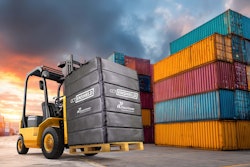Quick hits:
- Companies are taking aim at sustainability beyond recycling, and reduction in water usage is a key KPI, with some reports saying 40% of all water used in the U.S. is in manufacturing sites and power plants.
- Infinite Cooling, an MIT-spinoff, invented WaterPanel, which uses electrodes to ionize air and charge droplets, then collect them via an electrostatic mesh on top of a cooling tower exhaust. The droplets drip down via gravity into trays below.
- This add-on process to capture cooling tower plumes’ water was inspired by the enhanced fog harvesting strategies of animals such as namib desert beetles.
- This technology is applicable to cooling towers in pharmaceutical manufacturing, at CPGs, and in food production—and it can be retrofitted to existing towers.
- Sharks: From Mortal Foes to Medical Inspiration
- Biomimicry Institute's Ray of Hope Prize (For 2021 Finalists, scroll down to Meet the 2021 Ray of Hope Prize Startups)
- ABB’s Adaptive Execution Takes a Leaf from Nature’s Book
 | Read the transcript below: |
Hi, I’m Keren Sookne with Take Five Video for Healthcare Packaging.
Today we’re talking about a startup poised to save manufacturers millions of gallons of water per year.
As companies take aim at sustainability beyond recycling, reduction in water usage is a key KPI… particularly as droughts and wildfires threaten so many states.
According to MIT-spinoff Infinite Cooling, “40% of all water used in the U.S. is in manufacturing sites and power plants. Much of this water leaves the facilities via high density water vapor from industrial cooling towers.”
Infinite Cooling was one of 10 nature-inspired startups selected to participate in the Biomimicry Institute’s 2021 Ray of Hope Prize. I’ll link to the finalists below.
Taking cues from animals’ enhanced fog harvesting strategies such as namib desert beetles, the company developed an add-on process to capture cooling tower plumes’ water.
Namib desert beetles put their heads down and angle their wing scales vertically into the flow of desert fog. Water droplets aggregate on bumps on their wings, and run down “troughs” between the bumps.
Infinite Cooling’s WaterPanel uses electrodes to ionize air and charge droplets, then collect them via an electrostatic mesh on top of a cooling tower exhaust. The droplets drip down via gravity into trays below.
This can save industrial facilities money, while saving hundreds of millions of gallons of water, depending on the application.
The reason it’s on our show today? This is applicable to cooling towers in pharmaceutical manufacturing, at CPGs, and in food production—and it can be retrofitted to existing towers.
This will hopefully alleviate some strain on local waterways, minimize costs, and increase safety in communities surrounding these facilities.
WaterPanel was installed on MIT’s Nuclear Reactor Laboratory research facility for stringent, 24/7 testing. The technology has to be sturdy enough to withstand heat, vibration, and extreme weather such as a harsh winters and summers, as MIT’s David Chandler explained.
According to chief technology officer Dr. Karim Khalil PhD, water collected in these tests was 100 times cleaner than the incoming cooling water.
Water contamination can be measured by testing conductivity, and plant cooling water tends to measure 3,000 microsiemens per centimeter. But water captured by WaterPanel typically measures under 50… actually cleaner than the water supply in Cambridge that usually measures 500 to 600 microsiemens.
So what’s next for Infinite Cooling? In June of 2021, they closed over $12 million in Series A financing. The system is now being prepared for full-scale tests in a commercial power plant and in a chemical processing plant. The company has also signed three contracts with industrial facilities across the US.
Thanks for watching today’s Take Five Video for Healthcare Packaging.






















